TOYOTA AVALON HYBRID 2021 Owners Manual (in English)
Manufacturer: TOYOTA, Model Year: 2021, Model line: AVALON HYBRID, Model: TOYOTA AVALON HYBRID 2021Pages: 560, PDF Size: 13.21 MB
Page 491 of 560
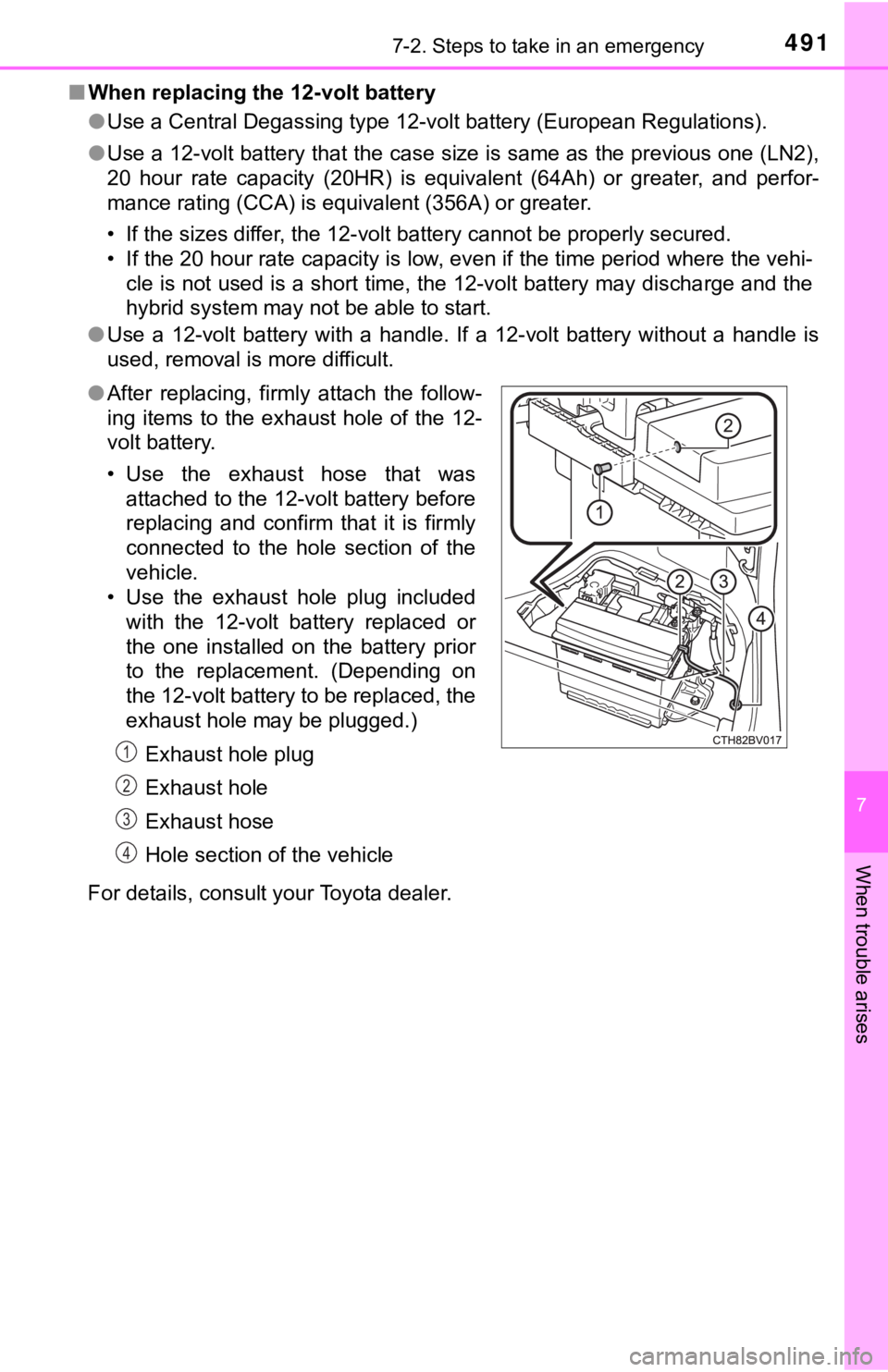
4917-2. Steps to take in an emergency
7
When trouble arises
■When replacing the 12-volt battery
●<003800560048000300440003002600480051005700550044004f000300270048004a004400560056004c0051004a00030057005c00530048000300140015001000590052004f00570003004500440057005700480055005c0003000b002800580055005200
53004800440051000300350048004a0058004f00440057004c[ons).
●Use a 12-volt battery that the case size is same as the previous one (LN2),
20 hour rate capacity (20HR) is equivalent (64Ah) or greater, and perfor-
mance rating (CCA) is equivalent (356A) or greater.
• If the sizes differ, the 12-volt battery cannot be properly secured.
• If the 20 hour rate capacity is low, even if the time period where the vehi-
cle is not used is a short time, the 12-volt battery may discharge and the
hybrid system may not be able to start.
●Use a 12-volt battery with a handle. If a 12-volt battery without a handle is
used, removal is more difficult.
For details, consult your Toyota dealer. ●After replacing, firmly attach the follow-
ing items to the exhaust hole of the 12-
volt battery.
• Use the exhaust hose that was
attached to the 12-volt battery before
replacing and confirm that it is firmly
connected to the hole section of the
vehicle.
• Use the exhaust hole plug included
with the 12-volt battery replaced or
the one installed on the battery prior
to the replacement. (Depending on
the 12-volt battery to be replaced, the
exhaust hole may be plugged.)
Exhaust hole plug
Exhaust hole
Exhaust hose
Hole section of the vehicle
1
2
3
4
Page 492 of 560

4927-2. Steps to take in an emergency
WARNING
■When removing the 12-volt battery terminals
Always remove the negative (-) terminal first. If the positive (+) terminal con-
tacts any metal in the surrounding area when the positive (+) terminal is
removed, a spark may occur, leading to a fire in addition to electrical shocks
and death or serious injury.
■Avoiding 12-volt battery fires or explosions
Observe the following precautions to prevent accidentally igniting the flam-
mable gas that may be emitted from the 12-volt battery:
●Make sure each jumper cable is connected to the correct terminal and that
it is not unintentionally in contact with any other than the intended terminal.
●Do not allow the other end of the jumper cable connected to the “+” termi-
nal to come into contact with any other parts or metal surfaces in the area,
such as brackets or unpainted metal.
●Do not allow the + and - clamps of the jumper cables to come into contact
with each other.
●Do not smoke, use matches, cigarette lighters or allow open flame near
the 12-volt battery.
■12-volt battery precautions
The 12-volt battery contains poisonous and corrosive acidic electrolyte,
while related parts contain lead and lead compounds. Observe the following
precautions when handling the 12-volt battery:
●When working with the 12-volt battery, always wear safety glasses and
take care not to allow any battery fluids (acid) to come into contact with
skin, clothing or the vehicle body.
●Do not lean over the 12-volt battery.
●In the event that battery fluid comes into contact with the skin or eyes,
immediately wash the affected area with water and seek medical attention.
Place a wet sponge or cloth over the affected area until medical attention
can be received.
●Always wash your hands after handling the 12-volt battery support, termi-
nals, and other 12-volt battery-related parts.
●Do not allow children near the 12-volt battery.
■After recharging the 12-volt battery
Have the 12-volt battery inspected at your Toyota dealer as soon as possi-
ble.
If the 12-volt battery is deteriorating, continued use may cause the 12-volt
battery to emit a malodorous gas, which may be detrimental to the health of
passengers.
Page 493 of 560
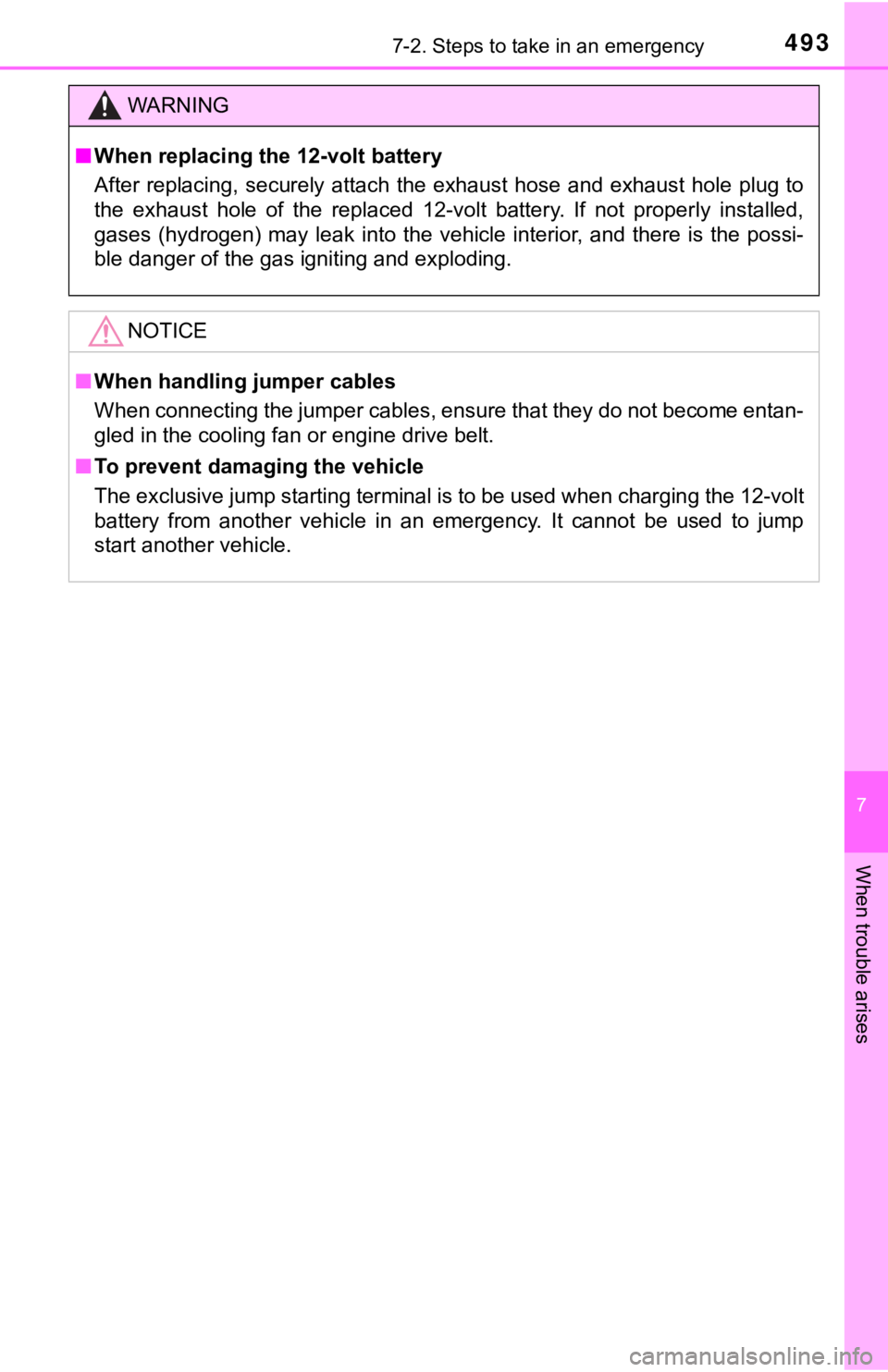
4937-2. Steps to take in an emergency
7
When trouble arises
WARNING
■When replacing the 12-volt battery
After replacing, securely attach the exhaust hose and exhaust hole plug to
the exhaust hole of the replaced 12-volt battery. If not properly installed,
gases (hydrogen) may leak into the vehicle interior, and there is the possi-
ble danger of the gas igniting and exploding.
NOTICE
■When handling jumper cables
When connecting the jumper cables, ensure that they do not become entan-
gled in the cooling fan or engine drive belt.
■To prevent damaging the vehicle
The exclusive jump starting terminal is to be used when charging the 12-volt
battery from another vehicle in an emergency. It cannot be used to jump
start another vehicle.
Page 494 of 560
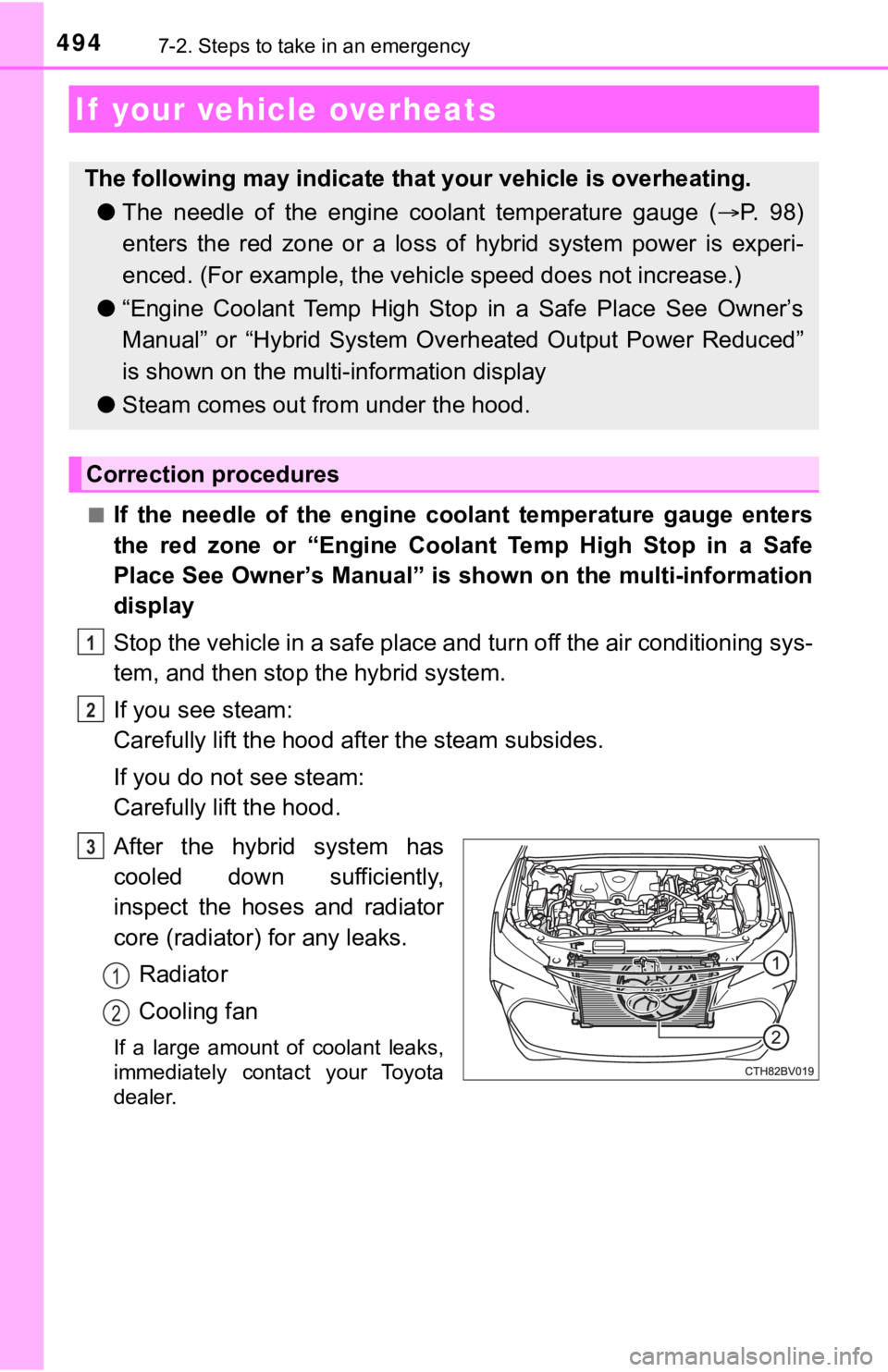
4947-2. Steps to take in an emergency
■If the needle of the engine coolant temperature gauge enters
the red zone or “Engine Coolant Temp High Stop in a Safe
Place See Owner’s Manual” is shown on the multi-information
display
Stop the vehicle in a safe place and turn off the air conditioning sys-
tem, and then stop the hybrid system.
If you see steam:
Carefully lift the hood after the steam subsides.
If you do not see steam:
Carefully lift the hood.
After the hybrid system has
cooled down sufficiently,
inspect the hoses and radiator
core (radiator) for any leaks.
Radiator
Cooling fan
If a large amount of coolant leaks,
immediately contact your Toyota
dealer.
If your vehicle overheats
The following may indicate that your vehicle is overheating.
●The needle of the engine coolant temperature gauge (P. 98)
enters the red zone or a loss of hybrid system power is experi-
enced. (For example, the vehicle speed does not increase.)
●“Engine Coolant Temp High Stop in a Safe Place See Owner’s
Manual” or “Hybrid System Overheated Output Power Reduced”
is shown on the multi-information display
●Steam comes out from under the hood.
Correction procedures
1
2
3
1
2
Page 495 of 560

4957-2. Steps to take in an emergency
7
When trouble arises
The coolant level is satisfactory
if it is between the “F” and “L”
lines on the reservoir.
Reservoir
“F” line
“L” line
Radiator cap
Add coolant if necessary.
Water can be used in an emer-
gency if coolant is unavailable.
Start the hybrid system and turn the air conditioning system on to
check that the radiator cooling fan operates and to check for cool-
ant leaks from the radiator or hoses.
The fan operates when the air conditioning system is turned on immedi-
ately after a cold start. Confirm that the fan is operating by checking the fan
sound and air flow. If it is difficult to check these, turn the air conditioning
system on and off repeatedly. (The fan may not operate in freezing tem-
peratures.)
If the fan is not operating:
Stop the hybrid system immediately and contact your Toyota dealer.
If the fan is operating:
Have the vehicle inspected at the nearest Toyota dealer.
4
1
2
3
4
5
6
7
Page 496 of 560
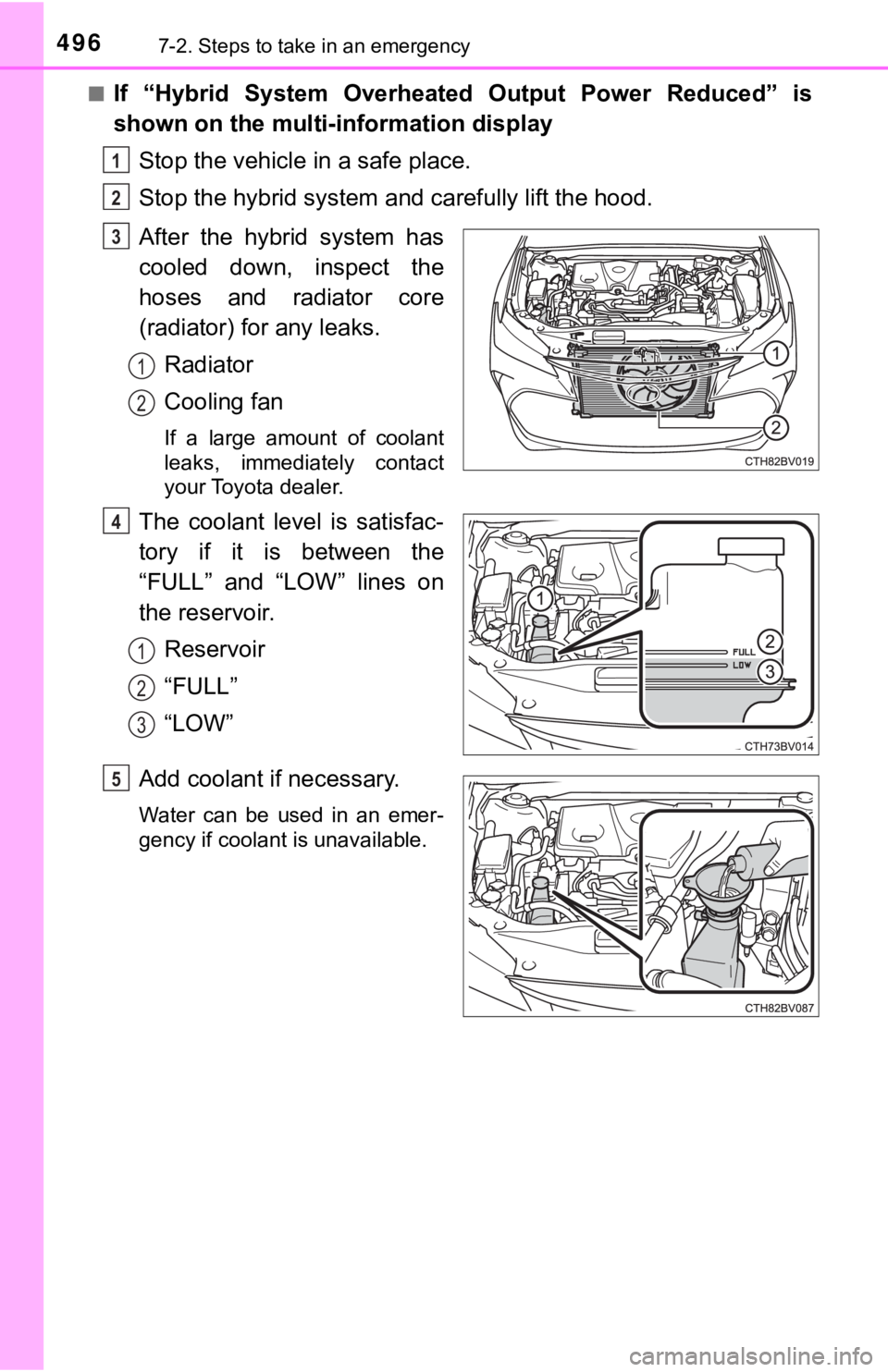
4967-2. Steps to take in an emergency
■If “Hybrid System Overheated Output Power Reduced” is
shown on the multi-information display
Stop the vehicle in a safe place.
Stop the hybrid system and carefully lift the hood.
After the hybrid system has
cooled down, inspect the
hoses and radiator core
(radiator) for any leaks.
Radiator
Cooling fan
If a large amount of coolant
leaks, immediately contact
your Toyota dealer.
The coolant level is satisfac-
tory if it is between the
“FULL” and “LOW” lines on
the reservoir.
Reservoir
“FULL”
“LOW”
Add coolant if necessary.
Water can be used in an emer-
gency if coolant is unavailable.
1
2
3
1
2
4
1
2
3
5
Page 497 of 560
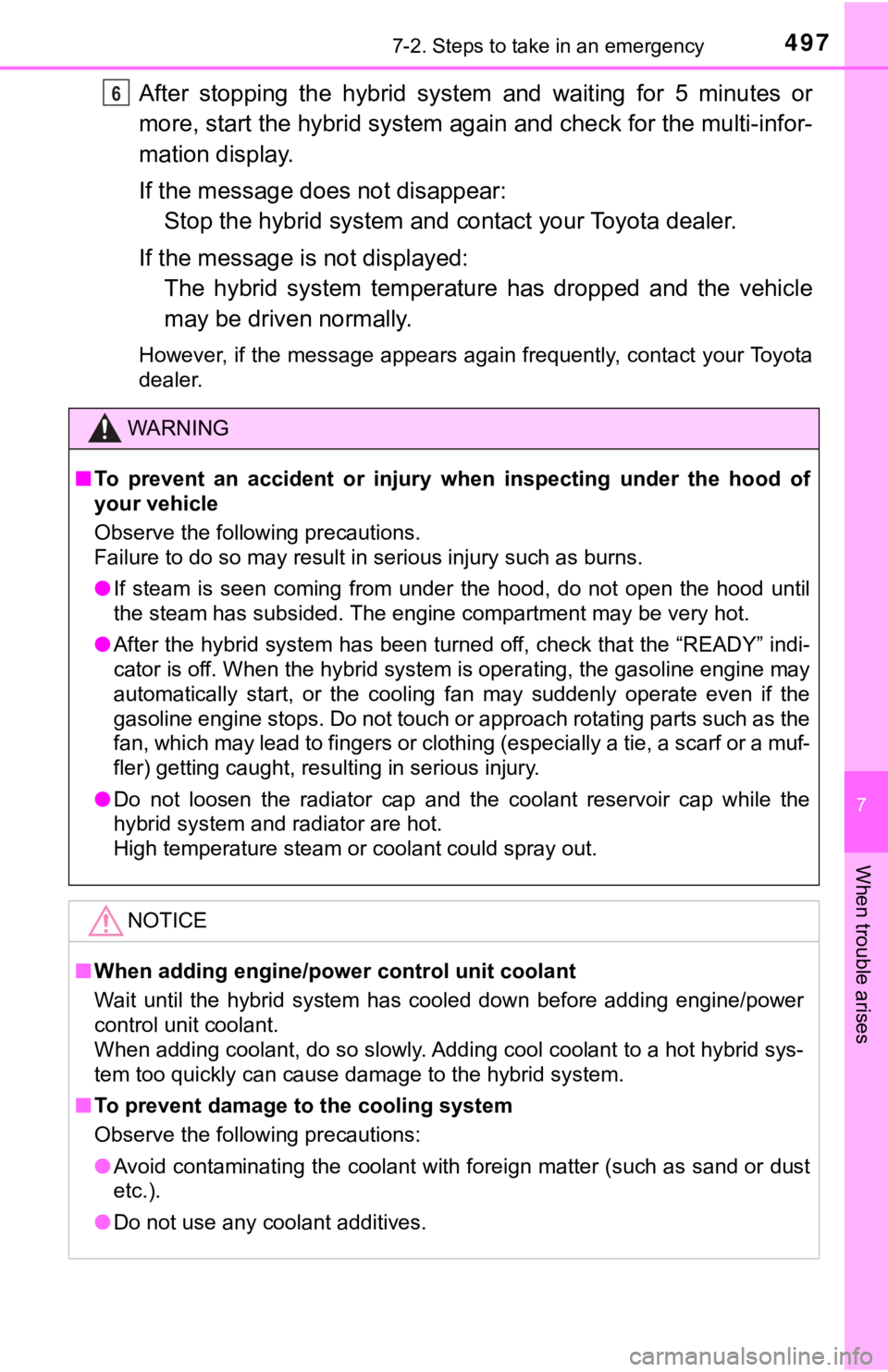
4977-2. Steps to take in an emergency
7
When trouble arises
After stopping the hybrid system and waiting for 5 minutes or
more, start the hybrid system again and check for the multi-infor-
mation display.
If the message does not disappear:
Stop the hybrid system and contact your Toyota dealer.
If the message is not displayed:
The hybrid system temperature has dropped and the vehicle
may be driven normally.
However, if the message appears again frequently, contact your To y o t a
dealer.
WARNING
■To prevent an accident or injury when inspecting under the hood of
your vehicle
Observe the following precautions.
<00290044004c004f005800550048000300570052000300470052000300560052000300500044005c00030055004800560058004f00570003004c00510003005600480055004c0052005800560003004c0051004d00580055005c0003005600580046004b00
03004400560003004500580055005100560011[
●If steam is seen coming from under the hood, do not open the hood until
the steam has subsided. The engine compartment may be very hot.
●After the hybrid system has been turned off, check that the “READY” indi-
cator is off. When the hybrid system is operating, the gasoline engine may
automatically start, or the cooling fan may suddenly operate even if the
gasoline engine stops. Do not touch or approach rotating parts such as the
fan, which may lead to fingers or clothing (especially a tie, a scarf or a muf-
fler) getting caught, resulting in serious injury.
●Do not loosen the radiator cap and the coolant reservoir cap while the
hybrid system and radiator are hot.
High temperature steam or coolant could spray out.
NOTICE
■When adding engine/power control unit coolant
Wait until the hybrid system has cooled down before adding engine/power
control unit coolant.
When adding coolant, do so slowly. Adding cool coolant to a hot hybrid sys-
tem too quickly can cause damage to the hybrid system.
■To prevent damage to the cooling system
Observe the following precautions:
●Avoid contaminating the coolant with foreign matter (such as sand or dust
etc.).
●Do not use any coolant additives.
6
Page 498 of 560
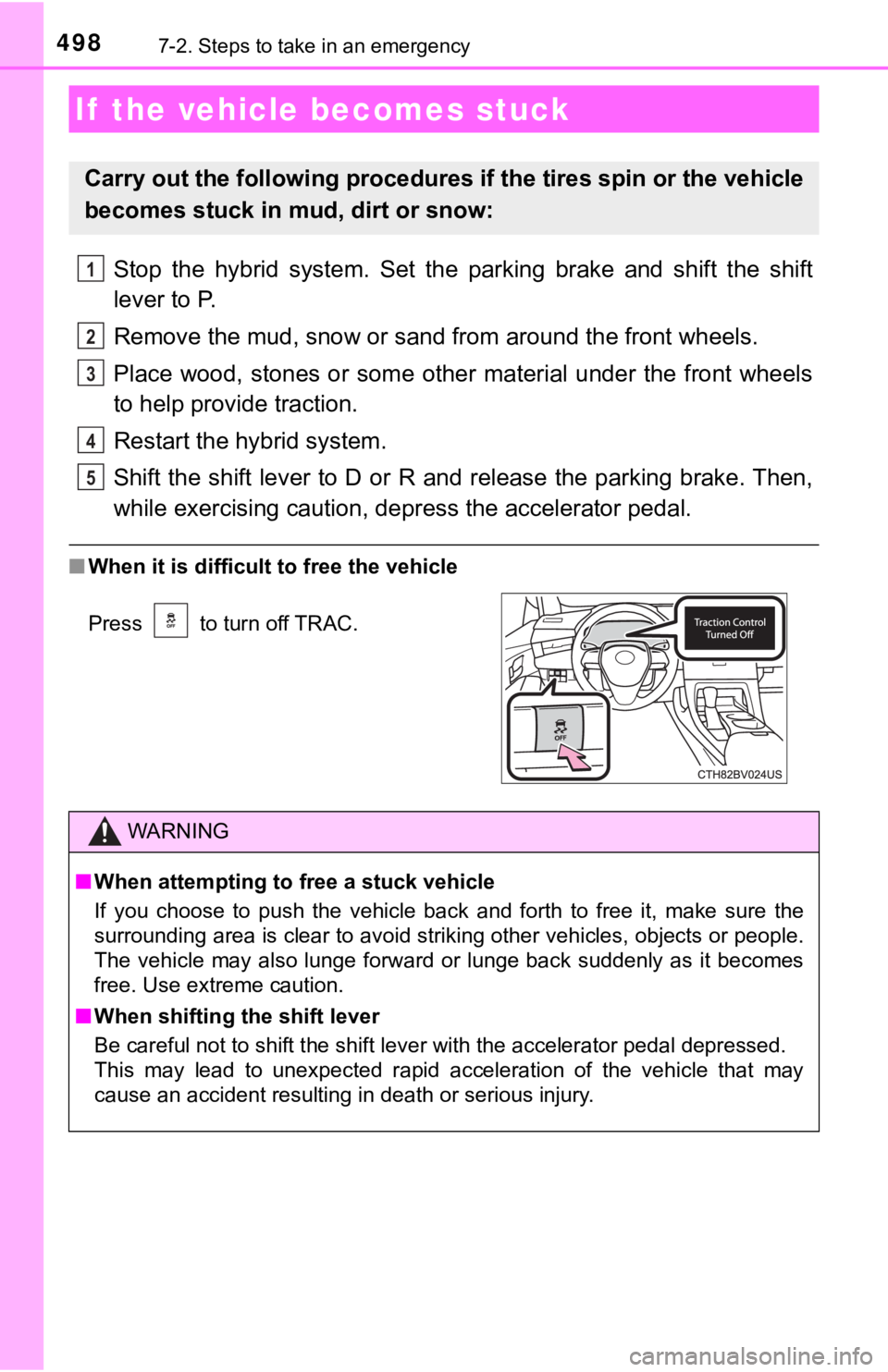
4987-2. Steps to take in an emergency
Stop the hybrid system. Set the parking brake and shift the shift
lever to P.
Remove the mud, snow or sand from around the front wheels.
Place wood, stones or some other material under the front wheels
to help provide traction.
Restart the hybrid system.
Shift the shift lever to D or R and release the parking brake. Then,
while exercising caution, depress the accelerator pedal.
■When it is difficult to free the vehicle
If the vehicle becomes stuck
Carry out the following procedures if the tires spin or the vehicle
becomes stuck in mud, dirt or snow:
1
2
3
4
5
Press to turn off TRAC.
WARNING
■When attempting to free a stuck vehicle
If you choose to push the vehicle back and forth to free it, make sure the
surrounding area is clear to avoid striking other vehicles, objects or people.
The vehicle may also lunge forward or lunge back suddenly as it becomes
free. Use extreme caution.
■When shifting the shift lever
Be careful not to shift the shift lever with the accelerator pedal depressed.
This may lead to unexpected rapid acceleration of the vehicle that may
cause an accident resulting in death or serious injury.
Page 499 of 560
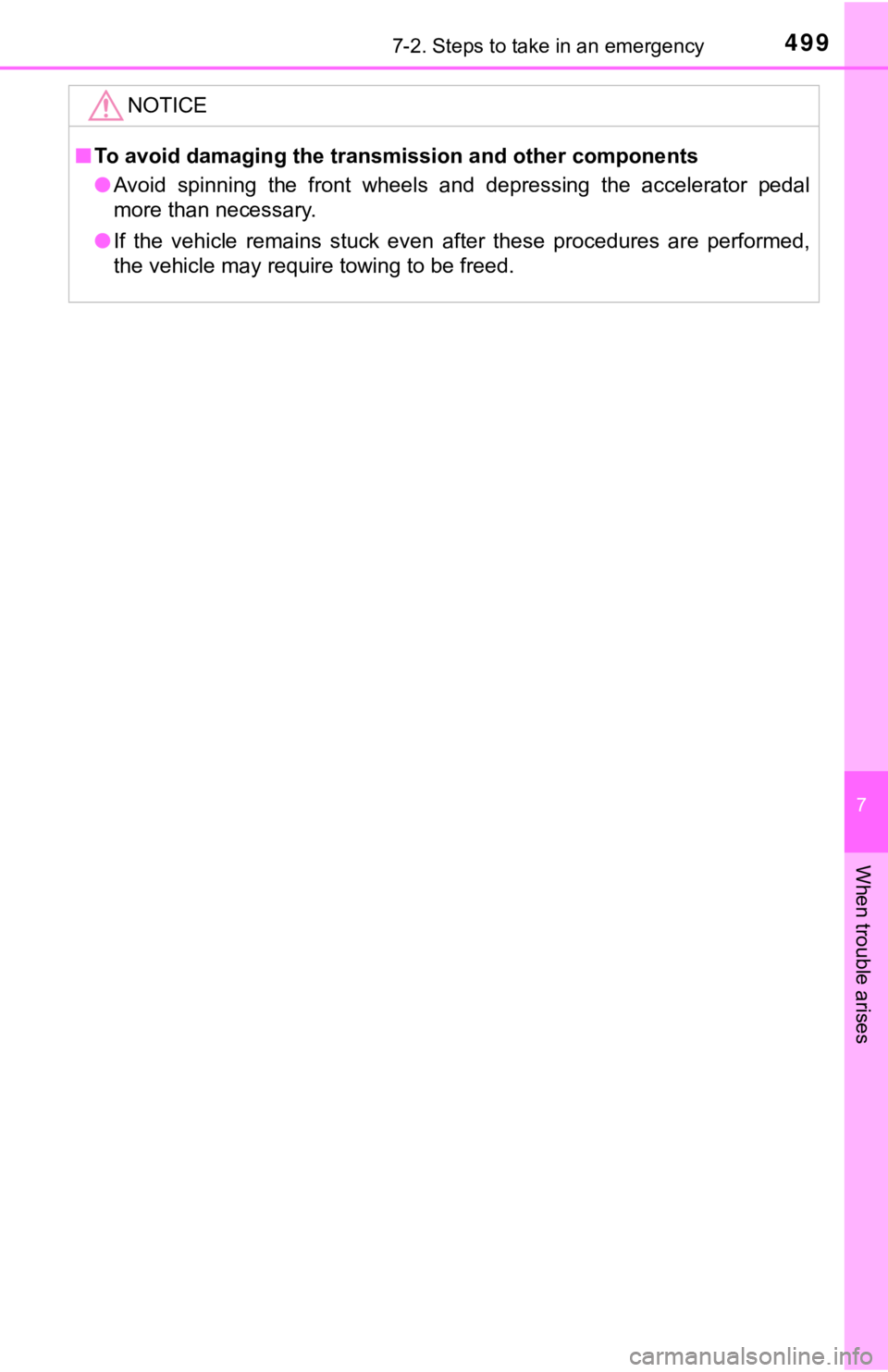
4997-2. Steps to take in an emergency
7
When trouble arises
NOTICE
■To avoid damaging the transmission and other components
●Avoid spinning the front wheels and depressing the accelerator pedal
more than necessary.
●If the vehicle remains stuck even after these procedures are performed,
the vehicle may require towing to be freed.
Page 500 of 560
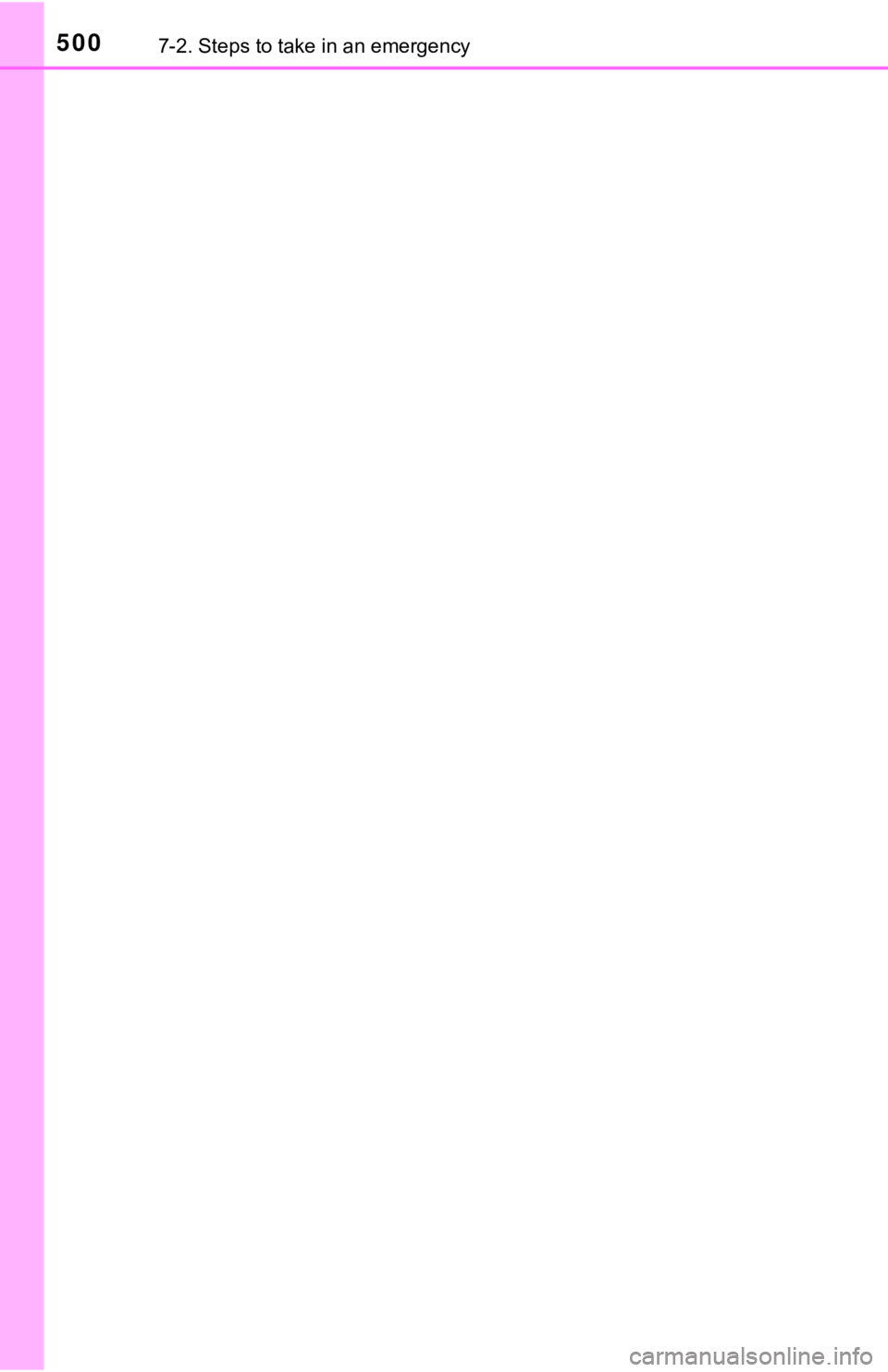
5007-2. Steps to take in an emergency